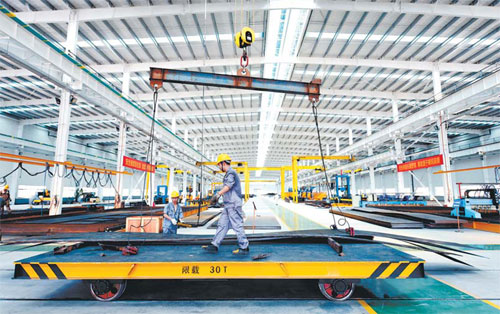
Zhanjiang Far East Steel Structure started trial production in early June and will export products to Indonesia in mid-July. (Provided to China Daily)
Fluency of locals in Southeast Asian languages is a major asset for development.
Having the only industrial park targeting the Association of Southeast Asian Nations in Guangdong province, the Fenyong High-Tech Industrial Development Zone in Zhanjiang has built close connections with Thailand and Indonesia and has made it a priority this year to attract investment from Southeast Asian countries.
Zhanjiang, the port city that is the southernmost on the Chinese mainland, is recognized by the National Development and Reform Commission as a strategic fulcrum city in the 21st Century Maritime Silk Road initiative.
The Fenyong zone is designated to pioneer the city's participation in the initiative, said Zou Yongbing, director of the zone's administrative committee.
The high-tech zone grew out of the Fenyong Overseas Chinese Farm, which was established in 1952 to offer resettlement opportunities for returning overseas Chinese.
Most of them returned from Southeast Asian countries including Indonesia, Malaysia, Singapore, Vietnam, Myanmar and Thailand, which are all along the 21st Century Maritime Silk Road.
About 66 percent of the zone's current residents are returned overseas Chinese and their relatives. Because of their fluency in Southeast Asian languages, they are especially welcomed by enterprises from ASEAN members, said Chen Anming, who was the high-tech zone's Party chief from June 2013 to January 2015.
"Fenyong has natural ties with ASEAN countries and we will rely on returning Chinese to develop the zone into an important platform for Guangdong to cooperate with ASEAN," Zou said.
The zone focused on forging partnerships with Thailand and Indonesia in the first half of this year and has achieved significant results, he said.
Thailand's Trade Development Commission of Small and Medium-Sized Enterprises will soon set up an office in the zone and is discussing with the zone's administrative committee on establishing a China-Thailand industrial park in Zhanjiang.
The committee is also talking with major Indonesian companies including PT AKR, a leading company for logistics, supply chain and infrastructure, on setting up a China-Indonesia industrial park in the city.
"It is of utmost priority in our work in the forthcoming period to attract ASEAN enterprises to Fenyong. Our goal is to have three to five such enterprises in our industrial parks early next year," Zou said.
With a similar climate to Southeast Asia, Zhanjiang is suitable for growing many of the region's typical agricultural products and has a bright future for cooperation in the intensive processing of farm produce, he said.
The strength of ASEAN enterprises in the pharmaceuticals industry is also what the high-tech zone wants as its industrial plan gives priority to the development of such industries as food production, pharmaceuticals and machinery, he added.
"Fenyong speed"
The Fenyong high-tech zone was officially founded in 2013 and has been developing "in the fast lane" for the past two years, Zou said.
The zone had signed deals with 15 enterprises by the end of 2014, attracting total investment of 2 billion yuan ($322 million), and introduced another nine projects in the first five months of this year, adding investment of 4.4 billion yuan.
Seven of the first 15 enterprises were operational on June 8 and are expected to create total output value of 2.3 billion yuan annually.
Another seven are expected to be in operation by the end of this year and the remaining one next year. Construction of the nine new projects is also expected to start this year.
Zhanjiang Far East Steel Structure, a subsidiary of Baosteel Construction, started trial production in early June. Its first batch of high-end steel products, which weighs 1,000 metric tons and is worth 6 million yuan, will be exported to Indonesia in mid-July, said Chen Sheng, the company's general manager.
As a supporting enterprise for the Baosteel plant in Zhanjiang, the steel structure manufacturer was one of the first to enter the Fenyong high-tech zone.
It took only a little more than a year for the manufacturer to complete all construction and preparation for production after signing a deal with the zone's administrative committee in May 2014, thanks to the committee's highly efficient service.
The zone is also building a living compound to accommodate the staff of all businesses in the zone, which will ease the companies' financial burden, Chen said.
The general manager is optimistic about the steel plant's business prospects, eyeing annual output value of 1 billion yuan within three years, 60 percent of which is forecast to be from exports.
"The Belt and Road Initiative will bring large demand for steel structures, especially the high-end products, for the emerging economies in Southeast Asia," Chen said.
"There is no large-scale steel structure manufacturer within a radius of 300 kilometers. Through the Zhanjiang Port, we are able to cut the shipment distance to Southeast Asian countries by half, compared to our parent company in Shanghai."
Chen compares Zhanjiang to the next Zhuhai, a special economic zone in Guangdong. However, Zou, the director of Fenyong's administrative committee, said Zhanjiang is not copying any other city's development pattern but setting inspiring examples.
"Fenyong has made a miraculous transformation from a farm to a high-tech industrial zone, for which we couldn't find a precedent in China to follow," he said.
"The zone is developing at 'Fenyong speed' and I'm confident that by 2017, it will generate output value of 10 billion yuan and bring taxes of 300 million yuan every year."
To go full steam ahead, the Fenyong zone and Zhanjiang city still need preferential fiscal and tax policies to help them draw more investment, Zou added.
















































